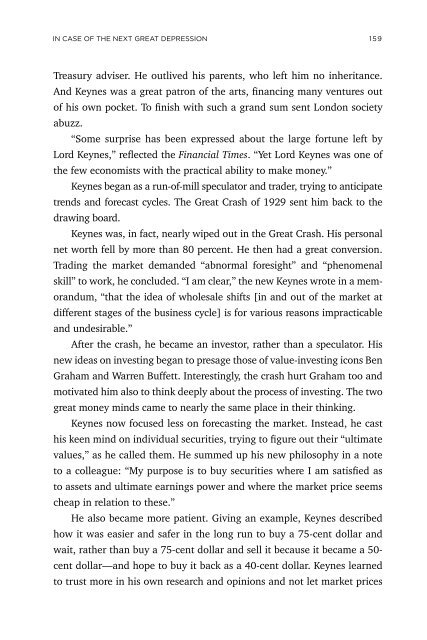Create successful ePaper yourself
Turn your PDF publications into a flip-book with our unique Google optimized e-Paper software.
IN CASE OF THE NEXT GREAT DEPRESSION 159<br />
Treasury adviser. He outlived his parents, who left him no inheritance.<br />
And Keynes was a great patron of the arts, financing many ventures out<br />
of his own pocket. To finish with such a grand sum sent London society<br />
abuzz.<br />
“Some surprise has been expressed about the large fortune left by<br />
Lord Keynes,” reflected the Financial Times. “Yet Lord Keynes was one of<br />
the few economists with the practical ability to make money.”<br />
Keynes began as a run-of-mill speculator and trader, trying to anticipate<br />
trends and forecast cycles. The Great Crash of 1929 sent him back to the<br />
drawing board.<br />
Keynes was, in fact, nearly wiped out in the Great Crash. His personal<br />
net worth fell by more than 80 percent. He then had a great conversion.<br />
Trading the market demanded “abnormal foresight” and “phenomenal<br />
skill” to work, he concluded. “I am clear,” the new Keynes wrote in a memorandum,<br />
“that the idea of wholesale shifts [in and out of the market at<br />
different stages of the business cycle] is for various reasons impracticable<br />
and undesirable.”<br />
After the crash, he became an investor, rather than a speculator. His<br />
new ideas on investing began to presage those of value-investing icons Ben<br />
Graham and Warren Buffett. Interestingly, the crash hurt Graham too and<br />
motivated him also to think deeply about the process of investing. The two<br />
great money minds came to nearly the same place in their thinking.<br />
Keynes now focused less on forecasting the market. Instead, he cast<br />
his keen mind on individual securities, trying to figure out their “ultimate<br />
values,” as he called them. He summed up his new philosophy in a note<br />
to a colleague: “My purpose is to buy securities where I am satisfied as<br />
to assets and ultimate earnings power and where the market price seems<br />
cheap in relation to these.”<br />
He also became more patient. Giving an example, Keynes described<br />
how it was easier and safer in the long run to buy a 75-cent dollar and<br />
wait, rather than buy a 75-cent dollar and sell it because it became a 50-<br />
cent dollar—and hope to buy it back as a 40-cent dollar. Keynes learned<br />
to trust more in his own research and opinions and not let market prices


